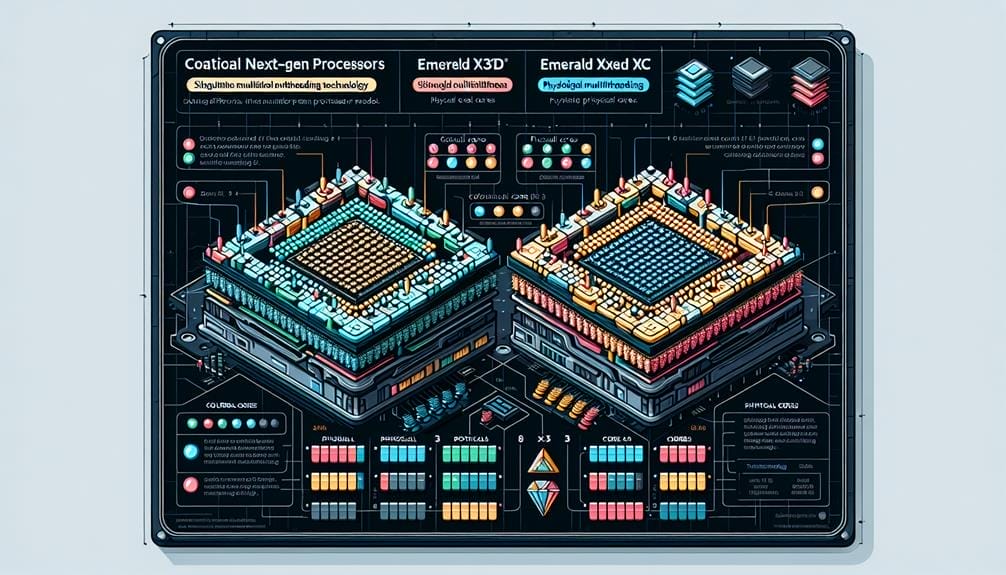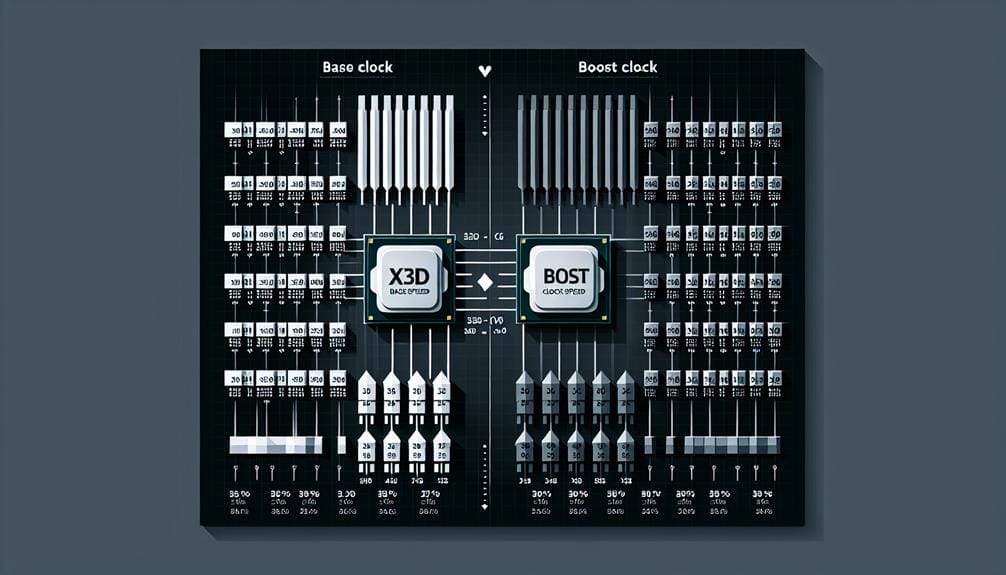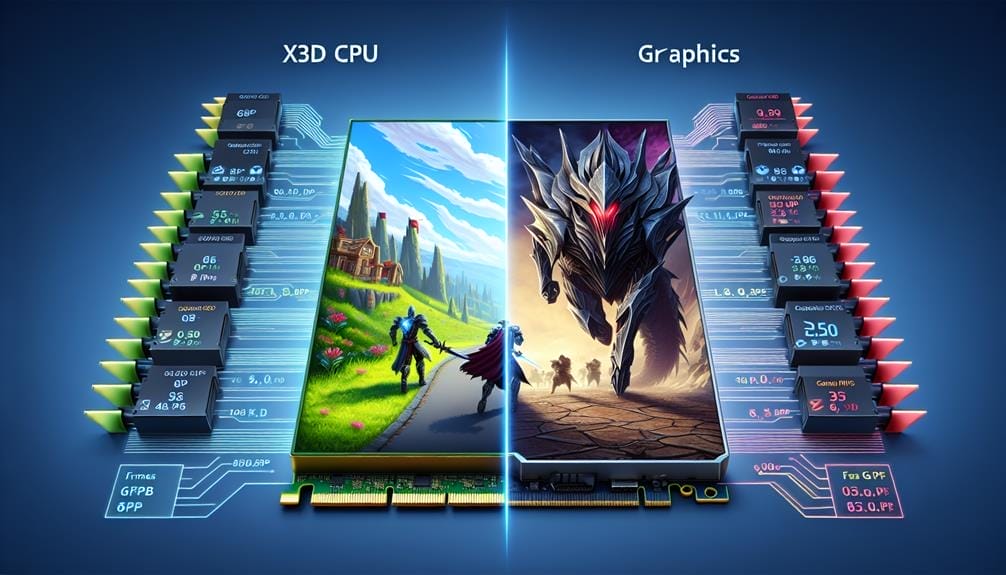Ryzen Showdown: X3D Vs X CPUs Unveiled

Recently, the technology community has been filled with excitement about the upcoming release of AMD’s Ryzen X3D CPUs. This anticipation has sparked widespread interest in how they will perform compared to the current X series processors.
The introduction of 3D V-Cache technology has set the stage for an intriguing showdown, as enthusiasts and professionals assess the practical implications and potential advantages of this innovation.
As we delve into the nuances of these new CPU variants, it becomes apparent that a thorough understanding of their differences is crucial for informed decision-making in the realm of modern computing.
Key Takeaways
- The X3D variants of AMD Ryzen CPUs have the same core and thread count as the X versions, but with a massive boost to L3 Cache known as 3D V-Cache.
- X3D CPUs have a downward adjustment to Base and Boost clock speeds and a lower peak operating temperature due to the 3D V-Cache.
- While the differences between X3D and X CPUs may not be noticeable for general desktop use, they become apparent in heavy-duty workloads, with X CPUs generally performing better in rendering and productivity applications.
- Ryzen X3D CPUs are tailored for gaming and generally show a strong boost in gaming performance compared to X CPUs, ranging from 5% to 20%.
AMD Ryzen X3D Vs X CPUs: Core and Thread Count

When comparing the core and thread count of AMD Ryzen X3D and X CPUs, it's essential to understand the subtle but impactful differences that define their performance capabilities.
In performance benchmarks, the X3D CPUs exhibit a boost in L3 Cache, known as 3D V-Cache, which enhances per-core performance.
However, the X3D CPUs have a downward adjustment to Base and Boost clock speeds, resulting in a performance loss in heavy-duty workloads, particularly in rendering and productivity applications.
Moreover, the X3D CPUs have a lower peak operating temperature due to the 3D V-Cache but are more sensitive to overheating and require more advanced cooling solutions.
When considering cooling requirements, the X3D CPUs demand more robust cooling setups to maintain optimal performance, while the X CPUs generally have more lenient cooling demands.
L3 Cache Boost: X3D Vs X CPUs
In comparing the L3 cache boost between AMD Ryzen X3D and X CPUs, the X3D variants notably feature a substantial increase in L3 Cache, known as 3D V-Cache, which aims to enhance per-core performance. The 3D V-Cache advantages include improved data access speeds and reduced latency, leading to enhanced overall CPU performance.
However, this advancement also necessitates additional overheating precautions due to the increased power and thermal demands. Users should consider efficient cooling solutions to mitigate potential overheating issues when utilizing X3D CPUs, especially during heavy workloads.
The implementation of 3D V-Cache demonstrates a significant technological leap, but it requires careful management to ensure optimal and stable performance, particularly in demanding computing tasks.
Base and Boost Clock Speeds: X3D Vs X CPUs

Comparing the base and boost clock speeds between AMD Ryzen X3D and X CPUs reveals notable differences in their operational frequencies and performance capabilities.
- Impact on Power Consumption
- X3D CPUs, despite having a lower base and boost clock speeds, exhibit improved power efficiency compared to X CPUs due to the 3D V-Cache technology.
- The X3D CPUs' lower clock speeds contribute to reduced power consumption, making them a more energy-efficient choice in certain workloads.
- X CPUs, with higher clock speeds, may consume more power under heavy loads, potentially impacting overall system power consumption.
- Compatibility with Existing Motherboards
- X3D CPUs may require BIOS updates for compatibility with existing motherboards due to the unique 3D V-Cache technology.
- X CPUs, with their standard architecture, are more readily compatible with a wider range of existing motherboard models.
- Choosing between X3D and X CPUs should consider the potential need for motherboard updates to ensure seamless compatibility.
This analysis highlights the nuanced considerations surrounding power consumption and motherboard compatibility when choosing between X3D and X CPUs.
Peak Operating Temperature: X3D Vs X CPUs
Displaying significant differences in their peak operating temperatures, the X3D and X CPUs under the AMD Ryzen series warrant comprehensive evaluation to understand their thermal performance implications. The X3D CPUs exhibit lower peak operating temperatures compared to the X CPUs, primarily due to the integration of 3D V-Cache technology. This has implications for thermal management and cooling requirements, particularly in scenarios where the CPUs are subjected to heavy workloads. To illustrate the disparity, the table below presents the peak operating temperatures for select X3D and X CPUs.
| CPU Model | Peak Operating Temperature (°C) |
|---|---|
| Ryzen X3D | 80 |
| Ryzen X | 90 |
| Ryzen X3D | 85 |
Understanding these distinctions is crucial for devising appropriate cooling solutions and ensuring optimal performance and longevity of the processors. Therefore, when considering thermal management and cooling requirements, the differences between X3D and X CPUs are essential to address.
[//]: # (This is a markdown table. The pipes (|) separate columns, and hyphens (-) are used to create the header. The numbers represent the content of the table.)
Performance Differences: General Use

The thermal performance disparities between the X3D and X CPUs in the AMD Ryzen series necessitate an exploration of their general use performance differences.
- User Experience:
Both X3D and X CPUs offer a seamless desktop experience for general use.
- Performance discrepancies become evident in heavy-duty workloads, with X3D CPUs exhibiting a performance loss in rendering and productivity applications.
- X CPUs are preferable for professionals, particularly in terms of pricing.
Rendering and Productivity Performance
In evaluating the rendering and productivity performance of AMD Ryzen X3D and X CPUs, it is crucial to consider their respective capabilities and limitations in handling multi-core workloads.
While X3D CPUs boast a massive boost to L3 Cache with 3D V-Cache technology, they suffer a performance loss in multi-core workloads compared to X CPUs. This performance loss is particularly evident in rendering and productivity applications.
Additionally, X3D CPUs have a downward adjustment to Base and Boost clock speeds. When considering price comparison, X CPUs are generally the better choice for professionals due to their superior performance in multi-core workloads and more favorable pricing.
It is also important to note that Intel historically has had an advantage in single-core performance, which may impact the choice between AMD Ryzen X3D and X CPUs for specific use cases.
Gaming Performance: X3D Vs X CPUs

Comparing the gaming performance of AMD Ryzen X3D and X CPUs reveals significant advancements in per-core capabilities with the introduction of 3D V-Cache technology in the X3D variants.
- Power Consumption Comparison
- X3D CPUs exhibit slightly higher power consumption due to the 3D V-Cache integration.
- X CPUs generally showcase more power-efficient characteristics, especially during gaming workloads.
- The power consumption difference is marginal in real-world gaming scenarios.
- Memory Compatibility Analysis
- X3D CPUs may demonstrate improved memory compatibility, benefiting from the refined architecture.
- X CPUs maintain reliable memory compatibility, catering to a wide range of DDR4 memory configurations.
- Both CPU variants are optimized for high-speed memory modules, enhancing gaming performance.
The gaming performance of Ryzen X3D versus X CPUs showcases notable advancements, with considerations for power efficiency and memory compatibility playing crucial roles in the overall gaming experience.
Conclusion
In conclusion, the comparison between AMD Ryzen X3D and X CPUs reveals significant differences in core and thread count, L3 cache boost, base and boost clock speeds, and peak operating temperature.
These variances result in notable performance disparities across general use, rendering, productivity, and gaming tasks.
Understanding these distinctions is imperative for individuals seeking to make informed decisions regarding the most suitable CPU variant for their specific computing requirements.

